The private tour we took on third day of the southern valleys of Cappadocia was the highlight of our trip. Well, let me say it this way – we had seen lots of pictures of Cappadocia, especially of the hot air balloons, from our friends and other visitors. So when we hiked through the amazing valleys, we had a bit of déjà vu. However, the cave cities we saw on our third day were unexpected and totally mind-blowing.
We visited ancient churches in Soğanlı, Sahinefendi, and Cemil, dating from around 1100 to about 1900 A.D. These towns offered cave-church exploring similar to the Göreme Open Air museum but off the beaten path with less crowds and the ability to view the cave drawings up-close. We also got to see traditional village living that has been unchanged for centuries.
There were numerous dovecotes, small holes carved into the caves for doves and pigeons, around the Soğanlı region. The holes were painted white to attract birds. The monks would then collect the feces left by the birds to use as fertilizer for the grapevines. Fascinating. As we stopped to take pictures of a cave house still being used, a couple of village women ran out to sell us their dolls. I had no use for a doll, but seeing their eagerness to make a sell drove my guilty conscience to add yet another item to my already-full backpack.
The Greek Church we visited in Cemil had herbs, squash, and apricots growing all around it. The farmer lady we paid to gain entrance had a symbiotic relationship with the cave. Tourists paid her a couple of Turkish Lira to enter the historical site and she, in turn, maintained the caves when she wasn’t farming.
Here are some pictures as we followed the tour guide around:
The common themes we saw throughout the churches gave me the title idea of “Eat, Pray, Die”. Since the monks or priests lived in or near their house of worship, the church-caves had designated storage rooms to keep grains, rice, dried meats, fruits and vegetables. Even though it was sweltering hot outdoors, the caves gave me goose bumps upon entering. They were perfect refrigerators for storing food. When the devout Christians weren’t eating, they were praying in one of the rooms painted with images of Jesus, Mary, the apostles, the cross and angels everywhere. Interestingly, all the eyes and in some cases the faces were scratched off these famous figures in one of the church-caves we visited in Soğanlı. We learned from our tour guide that the Christians carved out the eyes of the paintings before they were forced to relocate to Greece in the 1920’s, as part of the Turkish/Greek exchange. They allegedly ate the eyes to get the blessings of their holy ones. When they took their last breath, they were buried into the floors. We found holes carved into the floors in the shape of adults and children everywhere–in, out and around the cave-churches.
Now imagine you and three thousand other people are crouched in a dark low-ceiling damp cave. Your stomach growls, so you bend down to crawl-walk through a narrow passage way into the kitchen area. You see women grabbing grains, potatoes, and dried meat from a hallow crevice in the wall that functions as food storage to cook a meal in a red clay pot over the fire pit. Another woman on the opposite end is grinding spices on a lave stone. With your hunger now satisfied, you crawl down another tunnel and climb into an opening in the wall. You feel a gust of wind blowing around you—you’ve just entered the ventilation shaft that’s one hundred fifty meters long and about two meters in diameter. You can’t even see the bottom. You quickly grab onto one of the many indentations on the wall that function as a ladder to go and up down the various levels of the Kaymaklı underground city. You climb down to the eighth level, which is the lowest level. Thank goodness for the small candles planted throughout the tunnels and rooms; otherwise you would be blind as bat! Your exhausted body makes its way to your sleeping chamber. The women in your family are already fast asleep on the thick sheepskins. You’re worried about your father, who is standing guard at the opening of the cave. The Romans (or if you happened to be born five hundred years later, the Arabs) have been relentlessly attacking, but our location gave us the upper hand. At the slightest indication of an attack, the men block the cave opening with a massive round heavy rock. You say you nightly prayer to Jesus, and cross yourself. You’ve already spent a month down here and you hear rumors that you may be down here for at least another two months. As you attempt to sleep, you try to remember what its like to see the sunrise in the morning.
As we wandered from cave to cave Kaymaklı Underground City, I could picture what life must have been like for the Christians living here centuries ago. The Hittites originally occupied the region between 18th and 12th century B.C. and had built the first underground caves. These Bronze Age Indo-European speaking people had a love for the arts and even until this day, pottery makers use the Hittites techniques and designs. Then Persians arrived around the 6th century and gave the region its nickname of Land of Beautiful Horses. The Assyrians and Persian empires used to covet the horses of Cappadocia for their beauty. In between these power struggles by the Romans and Turks in the 3rd and 4th century, the Christians hid in the underground caves first created by the Hittites. Christianity was not yet an accepted religion and therefore the Christians expanded the underground tunnel network in order to protect themselves from the invasions of Romans and Turks. Kaymakli, one of the widest, is the most popular underground city, however Derinkuyu was the deepest. There are about 150 of these underground cities, of which only a small percentage has been uncovered. They are all interconnected by tunnels and are several levels deep (some are 85 meters or 279 feet deep).
Cappadocia was a land of intrigue, history, geological wonders and art. Every corner was a Kodak moment– literally. There just wasn’t enough space on our cameras or on this blog to show you the full beauty of this place. You just have to take my word and come see it for yourself.
Here are pictures from the Kaymaklı underground city:
.


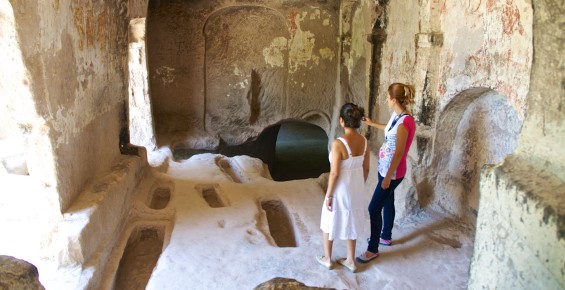
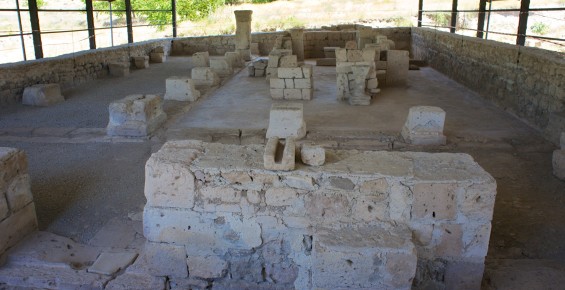
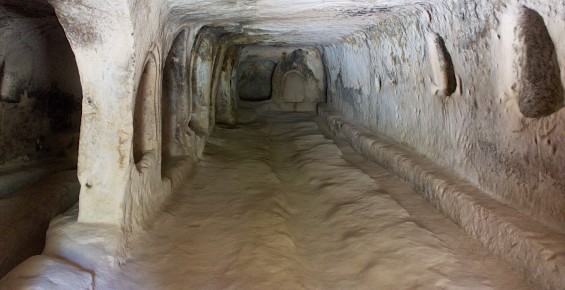
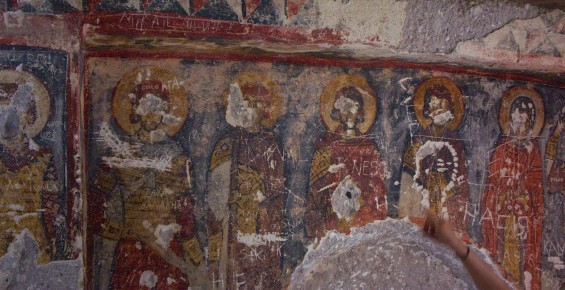
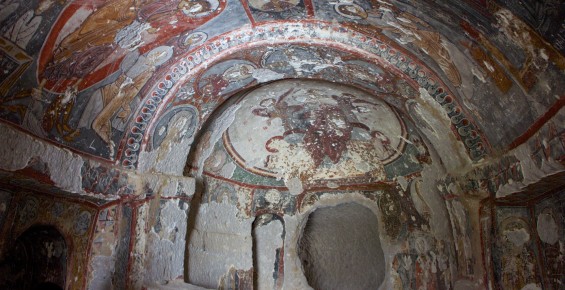

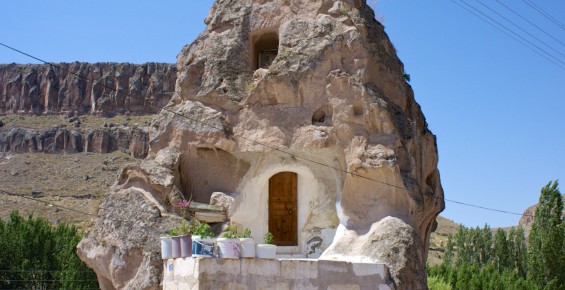
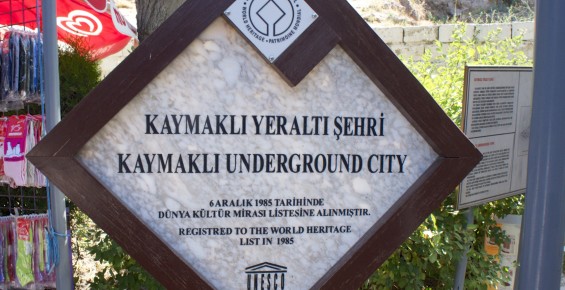
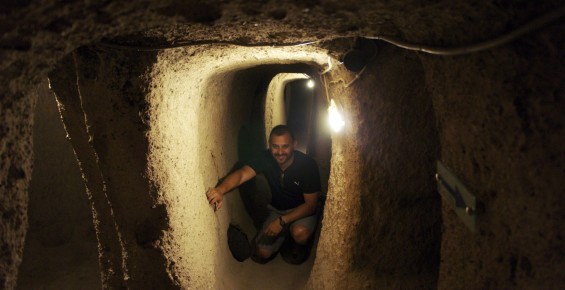
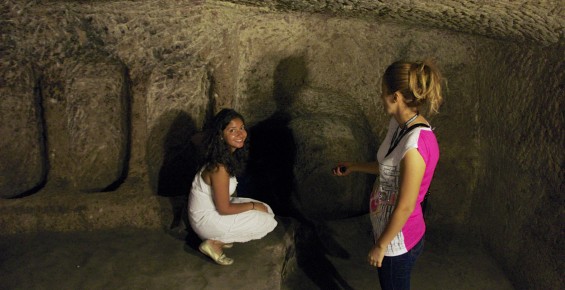
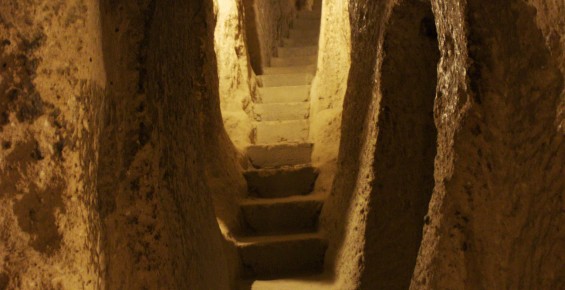

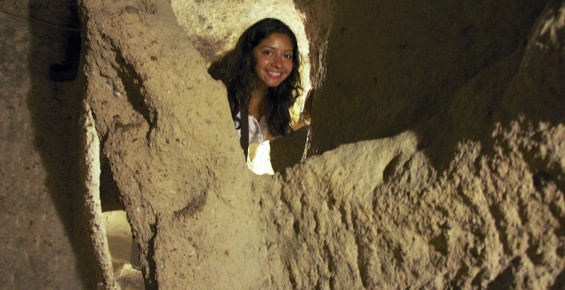
Fabulous history lesson, Humpty! You really know how to draw me into a story. I could feel myself in that ventilation shaft. Do you have idea why the Hittites built the caves in the first place?
Thank you! The ventilation shafts were quite breezy. The Derinkuyu underground city (we didn’t have time to visit it) has 18 floors and can house about 20,000 people! I can’t imagine living so far underground with a candle as my only source of light, but the level of sophistication is impressive. The Hittites had fresh ground water, communal rooms, kitchens, tombs, storage facilities and stables for animals. They also had a ton of escape routes and terrific strategy for protecting themselves from invaders (the narrow tunnels force people to enter single file). Archeologists believe that the Hittites built these underground caves as shelters when they were attached in 1200 BC.Later the Christians used them for the same purpose and built more of them.